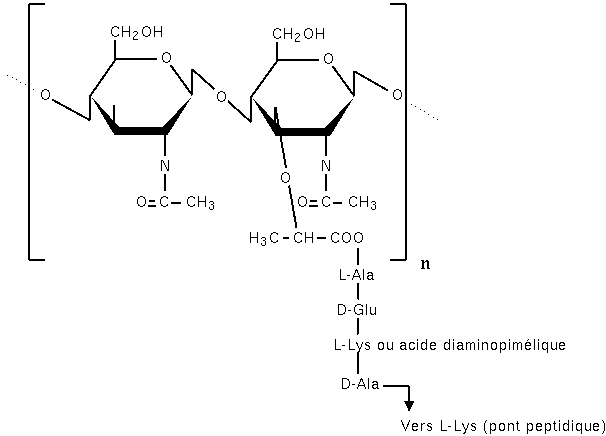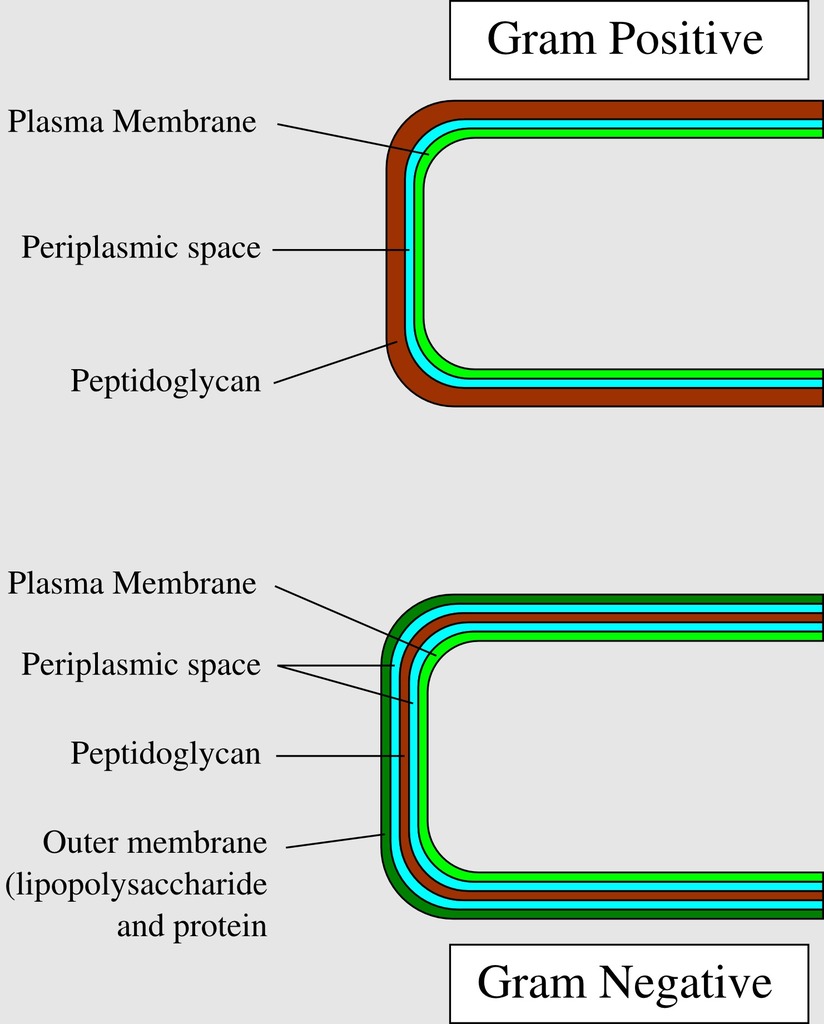In this article we will discuss about peptidoglycan and do bacteria have peptidoglycan.
Most of the bacterial plasma membrane is covered by a rigid, covalently linked polysaccharide and short polypeptide chains, forming the bacterial cell wall. Main purpose of bacterial cell wall is to provide bacteria with rigid structure and protects it from osmotic lysis.
11 facts you should know about peptidoglycan,
- Peptidoglycan is also known as murein. Where the word ‘murus’ means ‘wall’ in Latin.
- Peptidoglycan wall is present in both gram-positive and gram-negative bacteria.
- It is a heteropolysaccharide made of linear polysaccharide chains, connected by cross linking short peptides.
- Polysaccharide components of peptidoglycan are N– acetylglucosamine (NAG) and N-acetylmuramic acid (NAM). These two sugar derivatives are joined in an alternating fashion by β-1,4 glycosidic bonds.
- The peptide chains are connected to the glycan chain by substituting the D-lactoyl group of N-acetylglucosamine.
- The short peptide chains are usually a tetrapeptide composed of L-Ala, D-Glu, L-Lys, D-Ala respectively. Some bacteria replace L-Lys with another diamino acid, I.e., meso-2,6-diaminopimelic acid.
- Synthesis of peptidoglycan occurs in cytoplasm and then it is integrated into cell wall matrix.
- Gram-positive bacteria have much thicker peptidoglycan layer in their cell wall than gram-negative bacteria.
- The working mechanism of ‘Gram stain’, which helps us differentiate between gram-positive and gram-negative bacteria, is based on the difference in the amount of peptidoglycan layer present in their cell wall matrix.
- Peptidoglycan layer helps bacteria maintain their shape and it also protect bacteria from various environmental distress like changes in osmotic pressure and pH level.
- Microbes under the domain Archaea do not possess any peptidoglycan on their cell walls.

Do all bacteria have peptidoglycan?
Yes, all bacteria possess peptidoglycan layer.
Do only bacteria have peptidoglycan?
No, bacteria are not the only organisms with peptidoglycan.
Cell wall of all prokaryotic unicellular organisms contain peptidoglycan; except Archaea and mycoplasmas.
Which types of bacteria have peptidoglycan?
All kinds of bacteria, both gram-positive and gram-negative contain peptidoglycan.
Which bacteria do not have peptidoglycan?
Only bacteria belonging to family Chlamydiaceae lack peptidoglycan in their cell walls.
Do gram negative bacteria have peptidoglycan?
Yes, gram-negative bacteria have peptidoglycan.
In between the cell plasma membrane and outer membrane, I.e., the periplasmic space of gram-negative bacteria cell wall matrix contains thin peptidoglycan layers.
Do gram positive bacteria have peptidoglycan?
Yes, gram positive bacteria have peptidoglycan.
The cell wall of gram-positive bacterium is primarily made of peptidoglycan and teichoic acid. Plasma membrane of gram-positive bacteria is covered with thick layers of peptidoglycan.

What is the relationship between gram stain and peptidoglycan?
Gram-staining method uses crystal violet dye as the coloring agent to dye the cell envelop.
In this method, after staining the cell with crystal violet, iodine is used to increase dye retention capacity of cell. Then they are treated with ethanol to wash away the color. The thick peptidoglycan layer of gram-positive bacteria works as a permeability barrier and retains the dye during ethanol treatment inside the cell giving it a purple color when observed under microscope.
In case of gram-negative bacteria, the crystal violet dye complex is washed during ethanol complex because the thin peptidoglycan layer cannot prevent the dye loss, giving the cell pink coloration when observed.
Do acid fast bacteria have peptidoglycan?
Yes, acid fast bacteria possess peptidoglycan.
Acid fast bacteria are gram-positive bacteria under Mycobacterium genus. Outer layer of their cell wall contains a thin layer of peptidoglycan, mycolic acid and various surface proteins.
They do not show proper coloration when being treated with gram-stain and so we use special method of dying these bacteria, known as acid-fast staining process.
Function of peptidoglycan in bacteria-
Peptidoglycan layer primarily acts as a rigid envelop providing cell with proper shape.
It also provides protection against environmental changes, protease activities etc.
Conclusion-
This heteropolysaccharide complex is not only responsible for bacterial protection or shape, it’s also imperative factor for virulence. We can conclude that peptidoglycan is an important part of the survival of microbial organisms.
Also Read:
- Millipedes examples
- Do animal cells have a central vacuole
- Is dna polymerase an enzyme
- Do muscle cells have mitochondria
- Biota examples
- Adenine structure in rna
- Is fructose substrate
- Genetic diversity types
- Cisternae in endoplasmic reticulum
- Nucleic acid monomer
Hi…..I am Pratyush Das Sarma, I have completed my Master’s in Biotechnology. I always like to explore new areas in the field of Biotechnology.
Apart from this, I like to read and travel.
